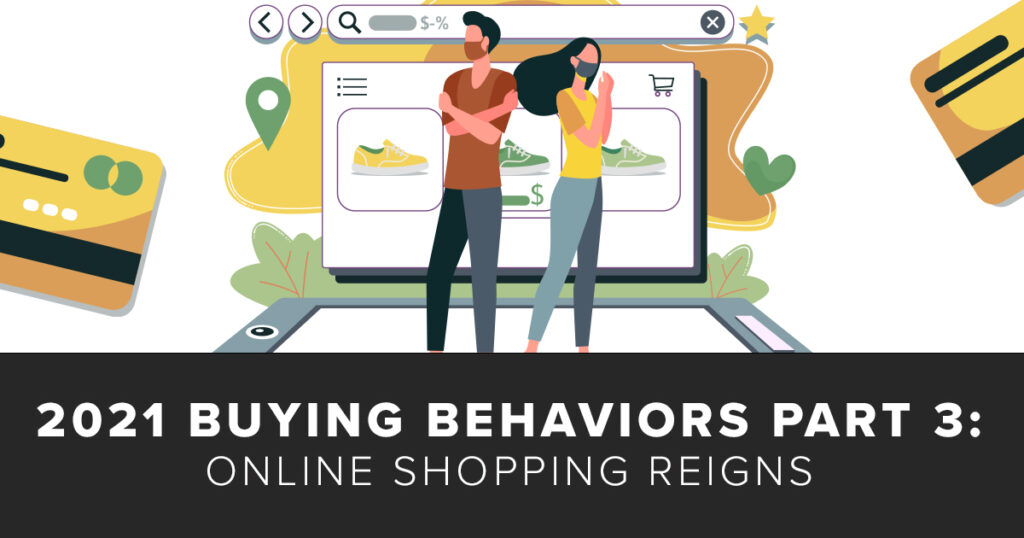Shifting Buying Behaviors Part 3: Online Shopping Reigns
Shifting Buying Behaviors Part 3: Online Shopping Reigns
Welcome to the third and final installment in our three-part series covering major shifts in consumer behavior since the start of the pandemic. This week, we’re focusing on online shopping.
In an effort both to avoid contracting COVID-19 and to avoid the long lines at brick and mortar stores due to capacity limitations, consumers are relying on online shopping now more than ever. In fact, “Consumers spent $861.12 billion online with U.S. merchants in 2020, up an incredible 44.0% year over year, according to Digital Commerce 360 estimates.” Amazon alone accounted for nearly a third of all ecommerce in the United States. And this massive shift towards online shopping is not just expected to go away after we reach herd immunity. Online shopping is convenient, you can do it in your pajamas, and companies not equipped with efficient, user-friendly e-commerce experiences need to catch up with the times before online mega-stores put them out of business.
According to Bazaarvoice, “49% of global consumers shop online more now than they did pre-COVID-19 and 62% of U.S. shoppers say they shop more online now than they did before the pandemic.” The rise of online shopping has been an ongoing trend and has continued to accelerate over the course of the pandemic.
Some of the reasons that people gravitate towards online shopping include price, convenience and informative shopping. Online prices tend to be lower than in-store prices, and finding coupons and deals on the internet is fast and easy. Additionally, advancements in technology have allowed for customer experiences in online stores to be very enjoyable. Modern navigation tools allow customers to quickly search for items they are looking for while generous return policies and free shipping eliminate the hassle of transporting goods to and from stores. Lastly, onsite reviews and testimonials of products, sizing and shipping give online shoppers information regarding what to order from whom, and what to avoid.
One of the major downsides of the ease of online shopping is that brand loyalty has decreased over the course of the pandemic: “73% of U.S. consumers have changed stores, brands or the way they shop.” (McKinsey). Increased frugality, efforts to buy locally, and attempts to support sustainable brands (as mentioned in our last blog) have also influenced the decrease in brand loyalty. According to McKinsey, “31% of U.S. consumers are changing to less expensive products to save money and 14% of consumers are turning to websites they’ve never previously visited to buy the basics.” Consumers are exploring their brand options both to ensure that they get the best prices and to ensure that they are buying from companies they feel comfortable supporting.
Smartphones and social media are another big driver of online shopping. During the pandemic, “US adult social media users spent 7 more minutes per day on social media in 2020 than 2019 – total of 82 minutes.” This increase in screen time means more exposure to social media ads or links to buy products. M-commerce (E-commerce is the term for online shopping from a computer; M-commerce refers specifically to online shopping from a smartphone) is expected to reach $284 billion, or 45% of the total U.S. e-commerce market, by the end of 2020. This makes sense when “45% of global consumers say they’re shopping more on their smartphone since COVID-19 began” (PwC). Many social media platforms have also recently adopted the use of “buy buttons,” which allow consumers to purchase products directly from their social platform. This new technology is highly effective: 76% of surveyed Instagram users reported having made an impulse buy on social media simply due to ease of purchase.
What does this mean?
Convenience is key when the world fits in the palm of your hand and your smartphone functions as your wallet. Consumers have recognized that e-commerce is the fastest and most convenient way to shop. In other words, online shopping isn’t going away anytime soon. So, it’s time for your business to adapt.
Our advice? First, make sure your website is built with e-commerce capability. Take a good, long look at your online customer journey and identify ways to simplify it. Make your checkout process as appealing and convenient as possible. Then, increase your social media presence. (This doesn’t just mean social ads; organic traffic also drives sales!)
That’s it for our series on shifts in buying behavior over the course of the pandemic. How has your company seen a shift in buyer behavior? Comment below, or on our Facebook or Instagram page, to let us know to let us know your thoughts.












